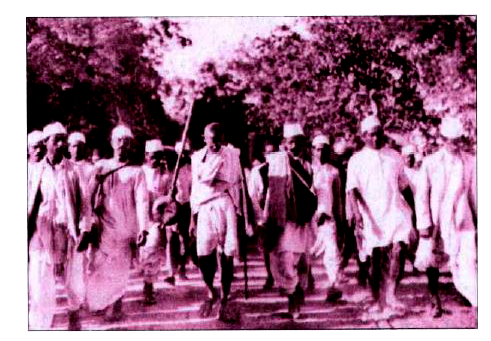The period between 1920 to 1947 was marked with major events and reforms that finally led us to our Independence. In this context, answer the following questions :
State three provisions of the Gandhi-Irwin Pact as a result of the Civil Disobedience Movement.
Provisions of the Gandhi-Irwin Pact as a result of the Civil Disobedience Movement : Since the satyagraha could not be suppressed, the Government, through Tej Bahadur Sapru and Jayakar, started negotiations with Gandhiji in jail. This resulted in the signing of a pact by Gandhiji and Lord Irwin, the Viceroy, in March 1931. This is known as the Gandhi-Irwin Pact. The government agreed to:
(i) To allow people living near seashore to manufacture salt.
(ii) Release all political prisoners, except those guilty of violence.
(iii) Permit peaceful picketing of liquor and foreign cloth shops.
(iv) Restore the confiscated properties of the Congressmen. PS.
The Congress, in its turn, consented to the following:
(i) To suspend the Civil Disobedience Movement.
(ii) To participate in the second session of the Round Table Conference.
(iii) Not to press for investigation into police assesses.
Similar Questions
The period between 1920 to 1947 was marked with major events and reforms that finally led us to our Independence. In this context, answer the following questions :
Mention any four clauses of the Cabinet Mission Plan.
View SolutionThe period between 1920 to 1947 was marked with major events and reforms that finally led us to our Independence. In this context, answer the following questions :
How did the Congress and the Muslim League respond to the Cabinet Mission Plan ?
View Solution
Knowledge Check
Arrange the following according to their chronological Order & select the answer by using codes given below:
1. Nehru Report
2. Gandhi-Irwin Pact
3. Poona Pact
4. Civil Diobedience MovementA4,1,3,2B2,3,4,1C1,4,2,3D3,2,1,4Arrange the following events in chronological order and select the correct answer from the codes given below:
I. Poona Pact
II. Gandhi-Irwin Agreement
III. Cripps Mission
IV. Civil Disobedience MovementAIV, II, III, IBII, IV, I, IIICIV, II, I, IIIDIII, I, IV, IIArrange the following events in chronological order and select the correct answer from the codes given below.
1. Gandhi-Irwin agreement
2. Poona Pact
3. Declaration of complete National Independence
4. Civil Disobedience CampaignA3,4,1,2B2,1,4,3C2,1,3,4D4,3,1,2
With reference to the National Movement from 1930 to 1947, answer the following:
State any three features of the Programme of the Civil Disobedience Movement launched in 1930.
View SolutionThe Quit India Resolution in 1942 was one of the final calls given by Gandhi for the Britishers to leave India. Moving towards Independence, Lord Mountbatten's Plan was significant. In this context, answer the following:
State two reasons for the launching of the Quit India Movement.
View SolutionIn 1930 Mahatma Gandhi's demands were rejected by the British, as a result of which he launched the Civil Disobedience Movement. In this context explain the following:
The Gandhi-Irwin Pact as a consequence of this Movement.

View SolutionThe Quit India Resolution in 1942 was one of the final calls given by Gandhi for the Britishers to leave India. Moving towards Independence, Lord Mountbatten's Plan was significant. In this context, answer the following:
Give any three effects of the Quit India Movement launched by Gandhi in 1942 that was significant to the last phase of the National Movement of India.
View SolutionRead the passage given and answer the questions that follow:
On 31 January 1930, Mahatma Gandhi sent a letter to Viceroy Irwin stating and imposing eleven demands. Among all the demands, the most stirring of all the demands was to abolish the salt tax that is consumed by the rich and the poor. The demands were needed to be fulfilled by 11 March or else the Congress will initiate a civil disobedience campaign. The popular salt march was started by Mahatma Gandhi and it was accompanied by 78 of his trusted volunteers. The march covered over 240 miles, from Gandhi's ashram in a place called Sabarmati to the Gujarati coastal town of Dandi. On 6 April he reached Dandi, and ceremonially violated the law, and started manufacturing salt by boiling seawater. This movement marked the beginning of the Civil Disobedience Movement
Identify the programmes of the Civil Disobedience Movement.
View Solution
